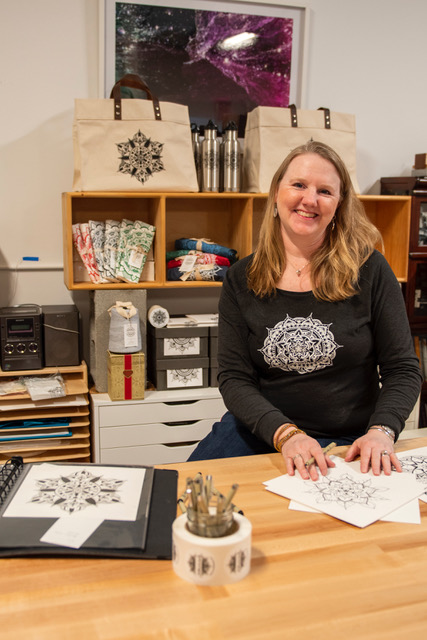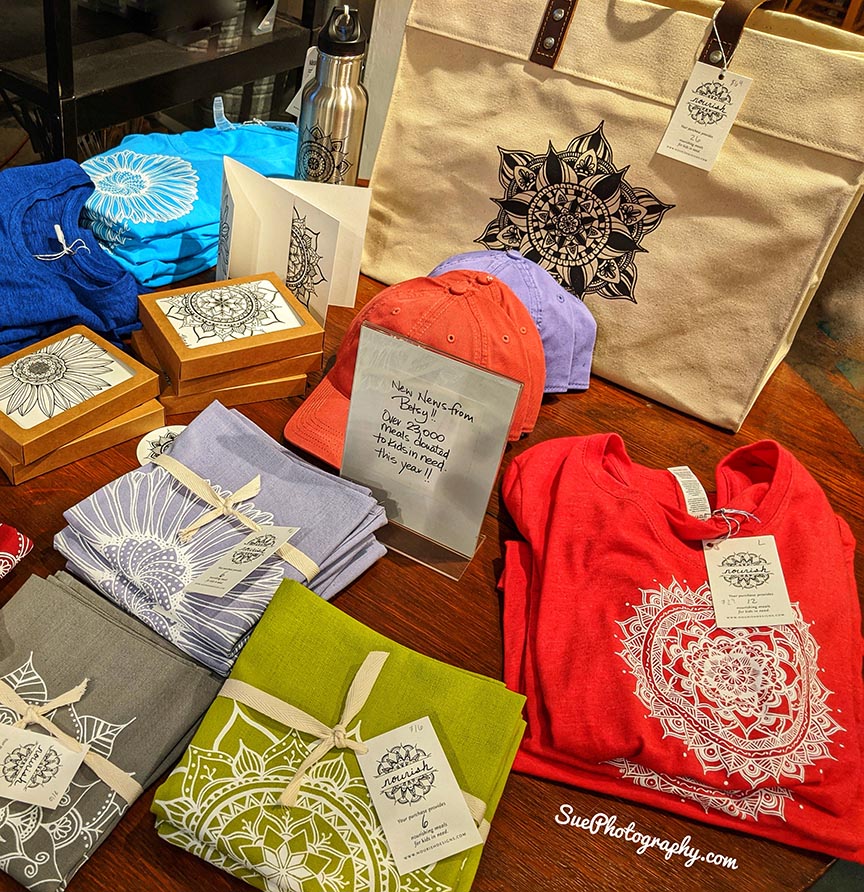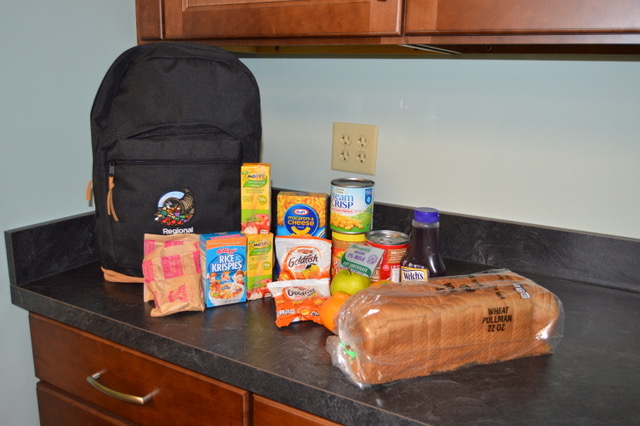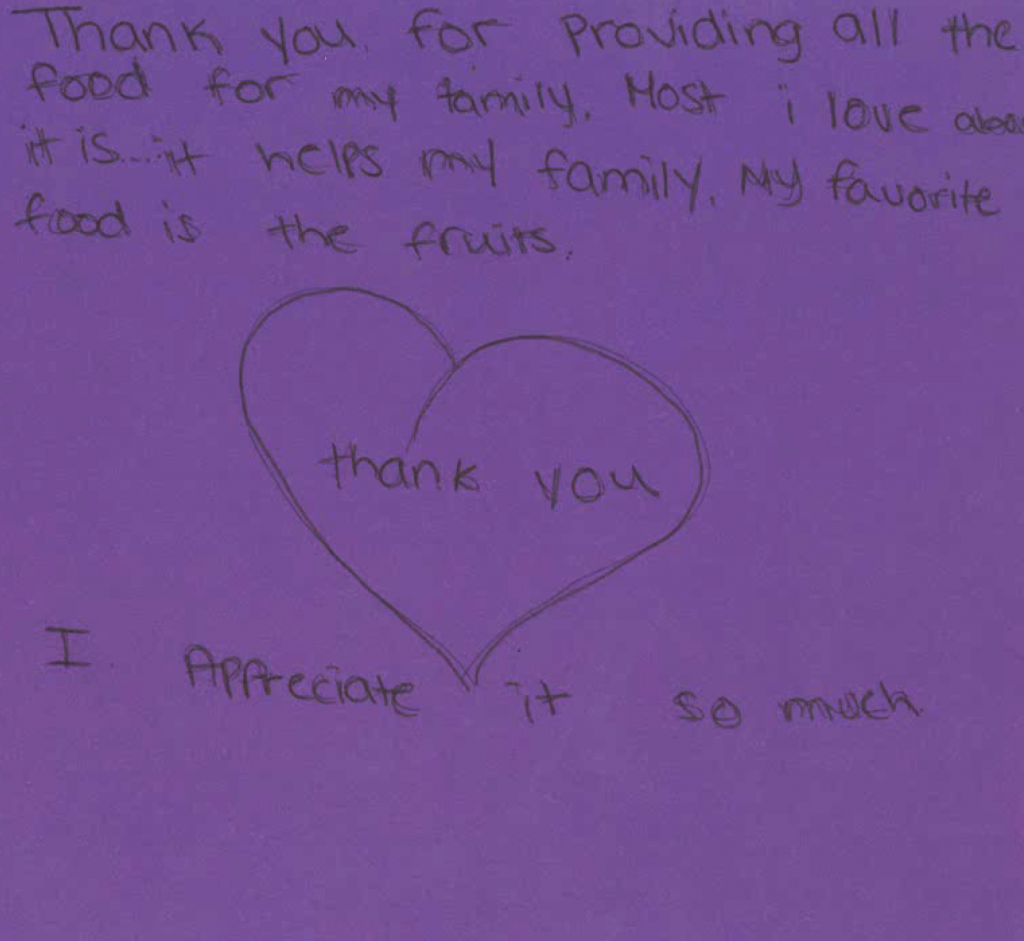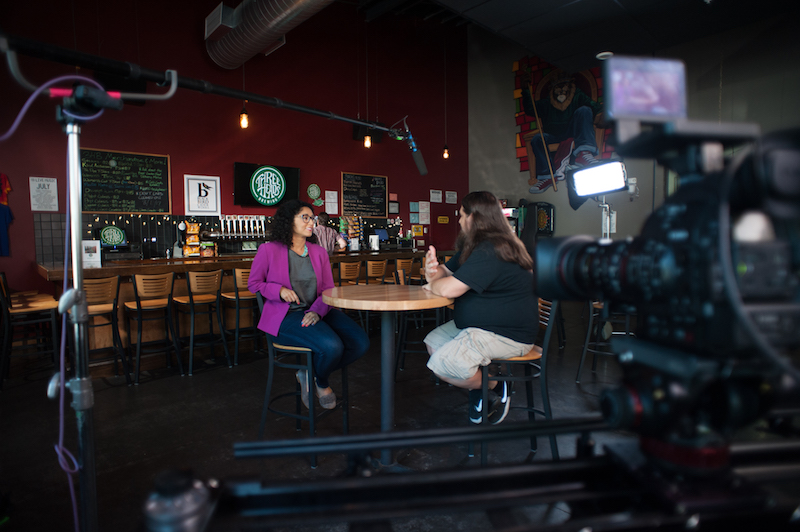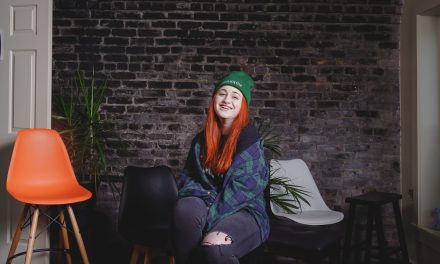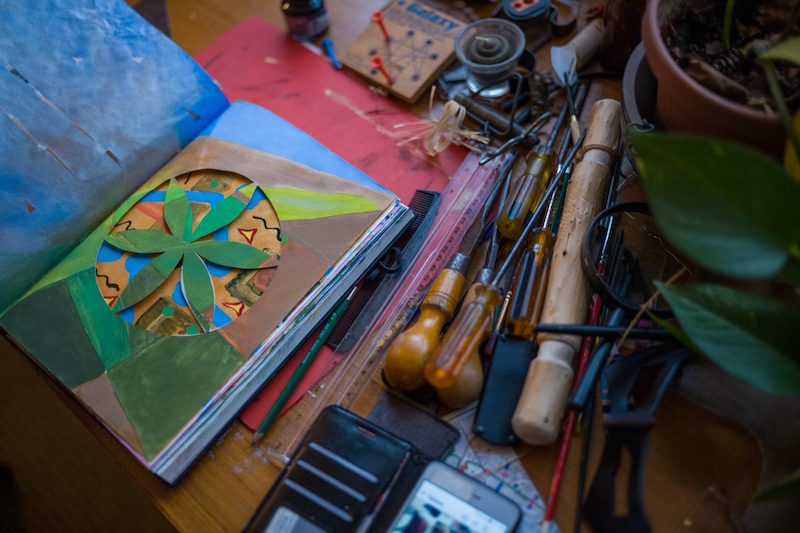Mandala maker, food provider
Current hometown: Ballston Spa
Age: 47
Current project: Continuing to grow and expand her business, which has already provided thousands of meals to kids throughout the region
Collaborative Media’s Maker of the Week is made possible by KeyBank.
Betsy Phelps Seplowitz never saw herself as an artist, but she found that making mandalas — geometric configurations sometimes defined as representing the universe, or the organizational structure of life, or the search or completeness — offered her meditative way to feed her soul. A little over a year ago, she found a way to link her pen-and-ink creations to feeding others in a literal sense, as well. Purchases of clothing, home goods and other items from her e-commerce site Nourish Designs are matched by meals sent home from schools to help address food insecurity for children and their families. While leveraging her background in nonprofit administration and fundraising has already helped the business to grow quickly, our talk revealed that she’s just getting started.
How do you define mandalas, and what got you interested in drawing them?
Mandala, in its simplest form, is defined as a circle. Generally, they have repetitive patterns; it becomes a kind of meditation, or it creates a quiet space for you to just focus with it. I kind of slid into drawing mandalas; I never would have described myself as an artist years ago. Really, mandalas are the only thing that I can draw (laughs).
When you say it creatives a meditative space, do you mean for the artist or the person viewing it? Or both?
I think for both… I grew up in a rural area in upstate New York, and spent a lot of time outside, a lot of time just looking at things and observing nature. I’ve always been drawn to patterns.
I’ve been a stay-at-home mom for the last 14 years, and I had to find some space to just kind of clear my mind. I started doodling, just on scraps of paper, and I found myself drawing patterns. They weren’t mandalas… they were just random patterns. And then at one point, I think I saw some (mandalas) somewhere… you know, they’re everywhere. They’re in church stained-glass windows; you find them in floor tiling. The more you look for them, the more you see them, because they’ve inspired people forever. I started drawing them in circular patterns… it provided me that space to just sit down, and to have my own time.
None of them are perfect, but everyone I finished… was kind of like a collection of that time, that peace that was just focused on me. No one else was needing anything. And then I started studying them more and more, in (terms of) techniques and all the different cultures that have pulled on mandalas… there’s one for nearly every culture.
So this is sort of your first foray into the artistic side of things?
That’s absolutely correct. I’m married to a fine art photographer, and his mom is an artist, so it’s always part of my life. I think that is something that allowed me to make this leap. My adult life has been in an environment where you find something that fascinates you and interests you, and you try it. You just go for it. I’ve never felt that I had to follow a specific path, so there’s always been room to kind of take a risk and go do something that inspires you.
And making a mandala is like following a path, either visually or meditatively. Is this just an artistic practice for you, or is there a spiritual element as well?
It certainly started as a pastime, as something to do. But maybe two years ago, I was at that point (where) my kids were getting older, (like) “OK, I need to make a move, it’s time for me to do my next thing.” What is that next thing going to be?
I actually took a summer, and I said “I’m not going to try to figure this out right now. I’m just going to clear my plates.” I had been involved on quite a few different volunteer boards, and really involved in my children’s schools. One of the things that I had been doing was supporting the BackPack Program at our local elementary school, where I would go to the Regional Food Bank once a week and pick up free produce and their allotted nonperishables for this program that provides meals over the weekend for kids in need. That was the only thing I kept on my docket. Everything I else I resigned from.
I drew a lot of mandalas in those two months, and the thought came to me like, “Wow, this is really feeding me. I feel more confident; I feel more at peace; I’m not so worried about what’s going to happen next.” I posted one on social media, just in my own personal account, like “This is what I’ve been doing.” People responded so positively to it, and they all said, “You’ve got to do something with these.” It was really like a spark, because I had just thought, “This is nourishing me; this is feeding me.” And I recognized that there’s got to be something I (could) do with these mandalas that supports the only thing that I kept on my docket, which was feeding kids.
Children not having something to eat, due to no fault of their own… is something that I really felt passionate about helping in any way that I could. (At) the end of September of 2019, we were in the car, and I said to my husband, “I have this idea.” And he said, “I think you should just go with it. Let’s just start… and see if we can make a business out of it.” I launched my first products in November; I scurried because I wanted to catch the holiday season. I had some dishtowels made. Nothing fancy; I found a local screen printer who would screen them by hand; I had the designs. (But) I didn’t have a website, I just posted them on social media and it was like, “Here’s what I’m doing. The business is going to be called Nourish. What do you guys think?”
And they all sold. Gone. I had some letterpress notecards made and a T-shirt and a tote bag, and I did my first event at a local nursery that I had ties to… (where) local crafters and vendors and makers could come set up a little pop-up. I was so warmly received, and it just has grown and grown from there.
How did you link it to providing meals for kids? How does that work?
Every product that I sell has a number of meals that are tied to it. So if you buy a T-shirt, it provides 12 meals through the Regional Food Bank that specifically supports children’s programs — which is mostly the BackPack Program. Throughout the Capital Region, they service 22 counties.
I wanted to be very transparent as to what impact every purchase was having. I didn’t want it to be like “10 percent of my profits,” because that’s so muddled… like I don’t have a profit yet; someday I will! (laughs) But no matter what happens, I am going to provide those 12 meals if you buy a T-shirt. So, to date, purchases have provided over 26,000 meals to the Regional Food Bank, and I can’t even believe that that is what’s happened.
Are you able to see that in action, the meals being distributed?
I have a connection with the coordinator of the children’s programs at the Regional Food Bank, so she shares with me some of the details, their stats and figures. It’s also a pretty protected program, in the sense that I don’t know any children that receive it. It’s very anonymous; it’s actually brilliant, because the children who receive these backpacks are chosen by the school. It’s not even like they have to have an adult sign them up for a program. The school has information; they, of course, coordinate with their guardians and their parents to say, “This is a program we’re offering, would you like your child to be included in it?” But it really helps the child.
The Regional Food Bank is using the schools to really identify the kids with greatest needs, rather than relying on a parent or guardian to have to fill out paperwork, if they… don’t want to fill out paperwork, aren’t able to fill out paperwork, whatever the case is. I know that, from their statistics, they serve nearly 7,000 kids every single week.
Every single week! That’s incredible.
Every. Single. Week. The specific school I work with, they send 50 backpacks home every Friday. And the kids bring their little backpacks back on Monday, and they receive it again full of food on Friday. That’s just one school in Ballston Spa… and the need is so much greater than that.
Since COVID has been here, it has really impacted so many more families. And the Food Bank, what they’re doing is just… incredible, the number of partnerships they’ve put together. And they’ve actually increased the amount of food that goes in those backpacks by about two-thirds, just to further supplement what these kids have. The backpacks are put together with the knowledge and intention that other siblings are going to have some of it, and families will be sharing from it. It’s not just like two little boxes of cereal and a carton of milk; it’s things that people can actually make meals with.
Did you know how big a problem this was?
I had no idea. I had no idea that there were so many children in our community. I think this is one of those things, when you are comfortable, you think, “Oh, it’s somewhere else.” And you really have no idea how many people are going without things that they really need. I had no idea.
Our school has 400 kids in it; it’s one of four elementary schools in Ballston Spa, and it’s providing 50 kids (with) backpacks, and the school tells me they could easily choose another 50 children. That’s here; I can’t even imagine other places where there isn’t the community support, which is one reason I rarely tie my funding to a specific community — because I want the Regional Food Bank to be able to use the funding where there is the greatest need. I worked in Schenectady for 10 years; I’m familiar with Troy. There are communities that just don’t have the resources to support a program like this, and so everybody kind of has to come together for the larger good.
One of the goals of your business is not just providing the meals, but also raising awareness of the food insecurity issue?
Absolutely. I do a newsletter… I try to always include something about what’s happening with food insecurity, whether it’s locally or national statistics. One of my goals for this upcoming year is to try to do more of that through social media, too, just so that people know that “people being hungry” isn’t an old-fashioned thing. It’s real; it’s right now.
Where does one get your products? You don’t have a storefront, right?
I do not have a storefront; my husband and I share a studio in Ballston Spa. When I started this business, I imagined doing events and maybe farmers’ markets; I was feeling it out. COVID hit very early on… I switched to an e-commerce business quite quickly, and I have thrived there. I am working to move pretty quickly to a national audience. Through the end of this (past) year, I have had customers from about half of the states in the nation, which is thrilling.
I’m hoping to do some larger-scale events as things open up this spring and move into the Berkshires or the Hudson Valley Region; I’m working to get my name out further, and my reach out further, because I think everyone in Ballston Spa already owns a Nourish shirt (laughs).
So when you say national audience… do you envision working with other food banks in other states?
I envision working with Feeding America, which is a national organization that supports all of the food banks across the country. That is my goal.
I needed to start locally; that’s where I knew people, and I knew the need, and I knew how the systems work. Where I am, right now, is kind of figuring out all those inroads and how they work. But my goal would be to support Feeding America, which would serve the same purpose… on a national level.
You mentioned you and your husband have a studio. Is that something home-based, or an actual freestanding studio space somewhere?
We have an actual studio. It’s his studio, but I keep taking over more and more and more of it (laughs).
He sounds like a very supportive guy.
He’s tremendous. He’s tremendous.
I was very interested in something you said on your website about your process with making the mandalas: “Like life, they are not necessarily perfect.” You don’t plan them in advance; you don’t use stencils; you just let them develop. You don’t even correct them; you don’t erase things!
No, I don’t (laughs). It’s kind of like a leap of faith. I sit down with my blank piece of paper, and my compass and my pen; I do give myself some circle guidelines. And I really let things evolve. I never erase anything. If you look at them, none of them are perfect; there’s flaws in all of them, but I think they’re there for a reason. The greater picture always ends up being perfectly fine, even with the flaws. And sometimes you incorporate the flaws and make them into something else.
There’s something just very calming and validating in finding a shape that you like, and then repeating it… and then adding another little squiggle, or another little line. And it’s all those little tiny pieces, that when they come together, make something so much greater.
Find our Maker online: Website, Facebook, Instagram
Wish to nominate a Maker of the Week? Email nominations.

